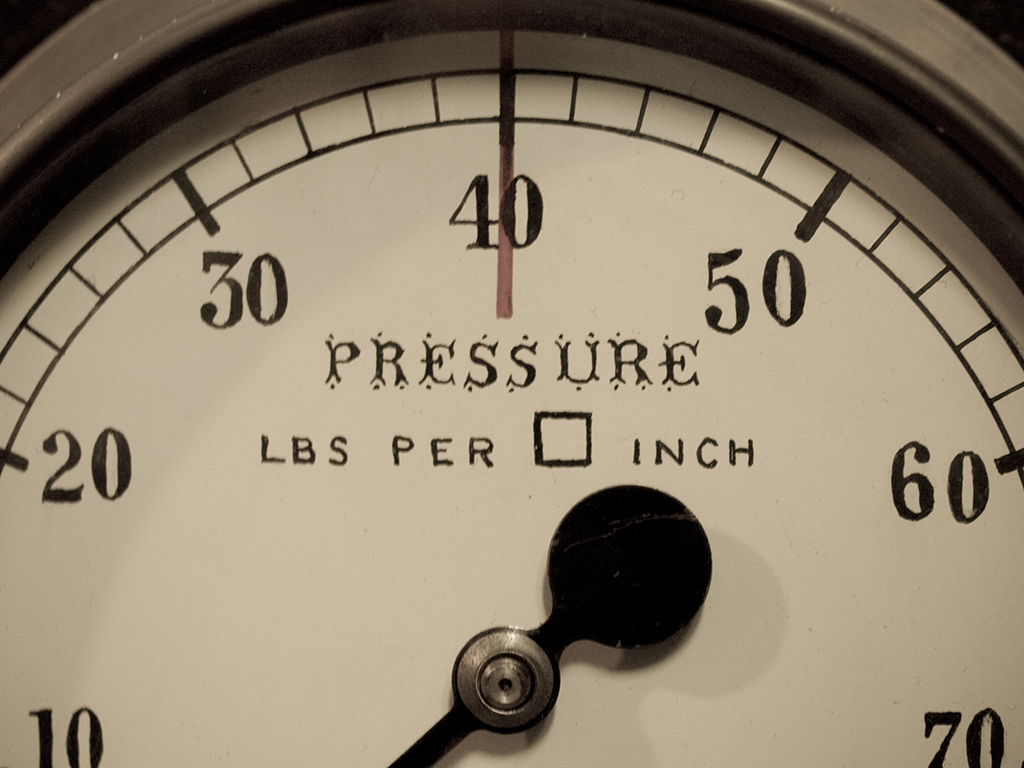Instruction
Do you feel the golf pressure cooker?

Does pressure in golf really exist?
Well, according to some researchers and experts, it really doesn’t. It’s all dreamed up by you to make it difficult for you to perform when it counts. According to a noted study (Beilock 2010), people create pressure for themselves. The only way we can ever experience pressure is to create it in our own minds. It is a product of our imagination. Another research paper explains that if we experience pressure, it is because we are projecting an imaginary view of the future (Markman et al 2008).
But, have these researchers ever had a 5-footer to win the match or had 20 friends standing around the first tee waiting for their opening tee shot and anticipating something great? Or have they ever acknowledged the pressure and used the energy as a positive tool that elevates their performance so they go beyond where they thought they could go?
Maybe not.
What is Pressure?
Well, the general definition gives us a good picture of what pressure is … “the feeling of stressful urgency caused by the necessity of doing or achieving something, especially with limited time.”
Do you know this feeling?
You practice and practice in a controlled environment you’ve created; hit a few balls tweaking your swing, watch some video to analyze your mechanics, create a few putting stations to work on your stroke and casually work on your game. All good.
But then you arrive at the first tee, and everyone and everything seems more serious. Someone hands you a scorecard and a pencil, and the feelings of your controlled environment now seem slightly out of your control.
Sound familiar?
Where Does Pressure Come from?
Pressure can come from both within you or from the outside. Your own expectations are often sources of pressure where you expect a lot (sometimes too much) from yourself. After all, you’ve worked hard, spent hours practicing and would like a good result. Expectations can also come from the outside. With young players, parents can pile on what kind of results they may be expecting. Coaches can expect results, too. Any kind of expectations invites pressure for players.
There are a number of sources that raise the boiling point and can give you the feeling of pressure:
- Thinking about your score (the outcome) and not focusing enough on “how” you are doing it on each shot (your process).
- Timing: You have four holes left and you need two birdies to win.
- I’m not ready: Your practice did not go well and you don’t feel ready.
- You’re working on something new: Will it work when it counts?
- The environment around you: Things are a little more serious than they were in practice.
- Media and audience effects: If you are playing in a big event, there’s lots of drama and opinions all around you.
- Doubting your own abilities: Can I do this?
- Perception of importance: Wow, this is a big event! The spotlight is on me!
What the best do
I have the great privilege to work with some of the world’s leading athletes, those who are constantly surrounded by “pressure” and we talk about it often.
The great players all acknowledge pressures, but work on creating the best approaches for themselves to deal with it and maximize their abilities. The very best I work with welcome pressures; it means they have the privilege of playing for something worthwhile and the opportunity to test the hours and hours of work they’ve put in to get to where they are.
Great players acknowledge the reality of pressure and don’t pretend it’s not there. Pressure, for them, is in perspective and always positive. Consider Jordan Spieth in the 2015 Masters, marching to the first tee through thousands of people on Sunday knowing he had the lead and he was four hours from history. You can be sure the 21-year-old felt the pressure on that day, but used it in a positive way to focus himself and go about his business with his personal game plan and experience and reflections from 2014.
How to best create positive pressure for you
Acknowledging that pressure exists and turning it into a positive is your first step forward. You can also better prepare yourself for pressure situations by following a few key steps that will, like the greats, keep pressure in perspective and use it to your advantage.
Here are a few ideas to start:
- Close the gap between practice and play. For most players, the level of attention and focus is completely different. Consider a more structured routine for your practice. Apply approaches to reach targets and goals. For example, to move on to the next phase of your practice, you must hit five shots in a row that meet a certain standard.
- Thinking ahead to what you can’t control creates fear and additional pressure. Keep your focus on each shot and executing to the best of your ability. The current shot is what you can truly control.
- Align your expectations with your abilities right now. What is reasonable for you right now? You might overestimate your abilities sometimes and even you can’t live up to them. This creates additional pressure. The expectations of others is not within your control and should not be a reasonable source of pressure for you.
- Build confidence proactively. Your confidence is built over time from the ground up. Allowing little dips in performance to impact your overall confidence will add pressure that will impact your performance.
- Stick to the plan. Develop a plan that plays to your strengths and don’t deviate from it unless conditions really change. Jordan Spieth relentlessly sticks to his plan and wears everyone down with it.
- Enjoy the environment and activity around you, but remember that focusing on you and not on the drama or others around you is what leads to high performance.
- Remember why you play. This seems simple, but it’s important. Golf and sports are not life or death. You play for enjoyment. Embrace the opportunity to feel the privilege of playing, competing and putting yourself in a position to do something meaningful.
So does pressure really exist? Yes. Should you be afraid of it? No. Can you use it to your advantage and become a better player if you do? Yes. Start accepting pressure, use it in a positive way and enjoy the feeling of having meaning in your game.
- LIKE65
- LEGIT20
- WOW3
- LOL1
- IDHT2
- FLOP1
- OB0
- SHANK3
Instruction
Clement: Laid-off or perfect fade? Across-the-line or perfect draw?

Some call the image on the left laid off, but if you are hitting a fade, this could be a perfect backswing for it! Same for across the line for a draw! Stop racking your brain with perceived mistakes and simply match backswing to shot shape!
- LIKE0
- LEGIT0
- WOW0
- LOL0
- IDHT0
- FLOP0
- OB0
- SHANK1
Instruction
The Wedge Guy: The easiest-to-learn golf basic

My golf learning began with this simple fact – if you don’t have a fundamentally sound hold on the golf club, it is practically impossible for your body to execute a fundamentally sound golf swing. I’m still a big believer that the golf swing is much easier to execute if you begin with the proper hold on the club.
As you might imagine, I come into contact with hundreds of golfers of all skill levels. And it is very rare to see a good player with a bad hold on the golf club. There are some exceptions, for sure, but they are very few and very far between, and they typically have beat so many balls with their poor grip that they’ve found a way to work around it.
The reality of biophysics is that the body moves only in certain ways – and the particulars of the way you hold the golf club can totally prevent a sound swing motion that allows the club to release properly through the impact zone. The wonderful thing is that anyone can learn how to put a fundamentally sound hold on the golf club, and you can practice it anywhere your hands are not otherwise engaged, like watching TV or just sitting and relaxing.
Whether you prefer an overlap, interlock or full-finger (not baseball!) grip on the club, the same fundamentals apply. Here are the major grip faults I see most often, in the order of the frequency:
Mis-aligned hands
By this I mean that the palms of the two hands are not parallel to each other. Too many golfers have a weak left hand and strong right, or vice versa. The easiest way to learn how to hold the club with your palms aligned properly is to grip a plain wooden ruler or yardstick. It forces the hands to align properly and shows you how that feels. If you grip and re-grip a yardstick several times, then grip a club, you’ll see that the learning curve is almost immediate.
The position of the grip in the upper/left hand
I also observe many golfers who have the butt of the grip too far into the heel pad of the upper hand (the left hand for right-handed players). It’s amazing how much easier it is to release the club through the ball if even 1/4-1/2″ of the butt is beyond the left heel pad. Try this yourself to see what I mean. Swing the club freely with just your left hand and notice the difference in its release from when you hold it at the end of the grip, versus gripping down even a half inch.
To help you really understand how this works, go to the range and hit shots with your five-iron gripped down a full inch to make the club the same length as your seven-iron. You will probably see an amazing shot shape difference, and likely not see as much distance loss as you would expect.
Too much lower (right) hand on the club
It seems like almost all golfers of 8-10 handicap or higher have the club too far into the palm of the lower hand, because that feels “good” if you are trying to control the path of the clubhead to the ball. But the golf swing is not an effort to hit at the ball – it is a swing of the club. The proper hold on the club has the grip underneath the pad at the base of the fingers. This will likely feel “weak” to you — like you cannot control the club like that. EXACTLY. You should not be trying to control the club with your lower/master hand.
Gripping too tightly
Nearly all golfers hold the club too tightly, which tenses up the forearms and prevents a proper release of the club through impact. In order for the club to move back and through properly, you must feel that the club is controlled by the last three fingers of the upper hand, and the middle two fingers of the lower hand. If you engage your thumbs and forefingers in “holding” the club, the result will almost always be a grip that is too tight. Try this for yourself. Hold the club in your upper hand only, and squeeze firmly with just the last three fingers, with the forefinger and thumb off the club entirely. You have good control, but your forearms are not tense. Then begin to squeeze down with your thumb and forefinger and observe the tensing of the entire forearm. This is the way we are made, so the key to preventing tenseness in the arms is to hold the club very lightly with the “pinchers” — the thumbs and forefingers.
So, those are what I believe are the four fundamentals of a good grip. Anyone can learn them in their home or office very quickly. There is no easier way to improve your ball striking consistency and add distance than giving more attention to the way you hold the golf club.
More from the Wedge Guy
- The Wedge Guy: Golf mastery begins with your wedge game
- The Wedge Guy: Why golf is 20 times harder than brain surgery
- The Wedge Guy: Musings on the golf ball rollback
- LIKE86
- LEGIT13
- WOW6
- LOL1
- IDHT0
- FLOP4
- OB1
- SHANK8
Instruction
Clement: Stop ripping off your swing with this drill!

Not the dreaded headcover under the armpit drill! As if your body is defective and can’t function by itself! Have you seen how incredible the human machine is with all the incredible feats of agility all kinds of athletes are accomplishing? You think your body is so defective (the good Lord is laughing his head off at you) that it needs a headcover tucked under the armpit so you can swing like T-Rex?
- LIKE0
- LEGIT2
- WOW2
- LOL0
- IDHT0
- FLOP0
- OB0
- SHANK2
-

 19th Hole2 weeks ago
19th Hole2 weeks agoDave Portnoy places monstrous outright bet for the 2024 Masters
-

 19th Hole3 days ago
19th Hole3 days agoJustin Thomas on the equipment choice of Scottie Scheffler that he thinks is ‘weird’
-

 19th Hole2 weeks ago
19th Hole2 weeks agoTiger Woods arrives at 2024 Masters equipped with a putter that may surprise you
-

 19th Hole3 days ago
19th Hole3 days ago‘Absolutely crazy’ – Major champ lays into Patrick Cantlay over his decision on final hole of RBC Heritage
-

 19th Hole2 weeks ago
19th Hole2 weeks agoTwo star names reportedly blanked Jon Rahm all week at the Masters
-

 19th Hole1 week ago
19th Hole1 week agoReport: LIV Golf identifies latest star name they hope to sign to breakaway tour
-

 19th Hole1 week ago
19th Hole1 week agoNeal Shipley presser ends in awkward fashion after reporter claims Tiger handed him note on 8th fairway
-

 19th Hole1 week ago
19th Hole1 week agoBrandel Chamblee has ‘no doubt’ who started the McIlroy/LIV rumor and why


















Jim
Feb 15, 2016 at 6:29 pm
All well and saying the above the reality is in a big tourny things ARE different.Your heart beat races and swing gets a little quicker and suddenly your trusted draw becomes a pull hook into the drink.Now your heart races faster and your mental process becomes a blur.
No amount of good practice on the range can prepare you for this .The golf world is filled with decent players who just can t perform under pressure and many prodigies who we never hear of again.
If it was that simple this would not be the case.
There are some who can handle it and many who cant its in your DNA.
Ever wonder how the same guys always hole the clutch putt on the last to win.?
John Haime
Feb 16, 2016 at 6:11 pm
Thanks for the comment Jim.
Yes, some have more talent than others and have higher levels of competitiveness etc. But, we have moved the needle on pressure with a number of athletes and it has made a noticeable difference in performance. It’s a process and most don’t/won’t do the work to make the changes. Thanks again – it’s a great topic for discussion.
Troy
Feb 15, 2016 at 1:15 pm
There’s no doubt we create our own pressure even if it’s just hitting in front of 20 friends at a local golf course. I agree aligning the practice we make to our actual game is one of the best ways to play through it and achieve optimal performance.
Most golfers are way too relaxed when practicing and playing a round of golf for them is hardly ever like that.
Cheers
ooffa
Feb 14, 2016 at 1:56 pm
What kind if pressure can there be on tour for most of the players. If they hit a good shot they are millionaire prima donna’s if they miss they are millionaire prima donna’s. Whats the diff if they win or come in second or third or 20th? Prize money is the smallest part of their income.
m smizz
Feb 14, 2016 at 12:50 pm
8. Don’t listen to the media